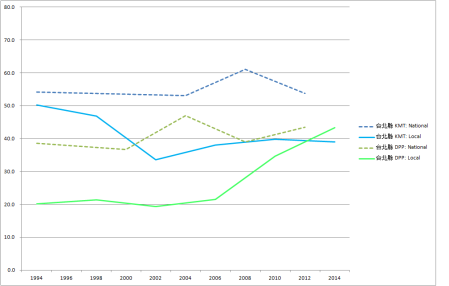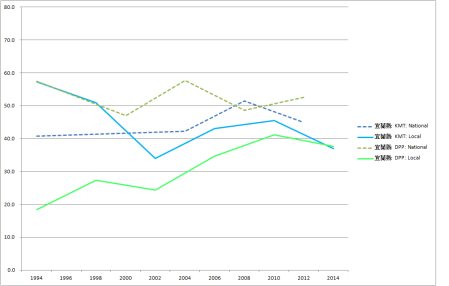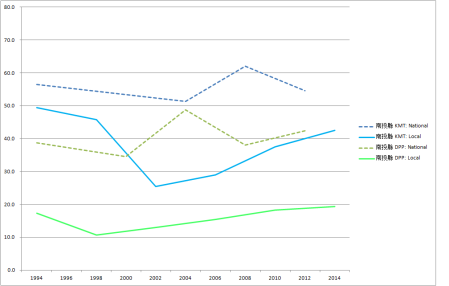I pay more attention to local assemblies than pretty much any other Taiwan scholar, with the exception of those who specialize in the politics of a specific area. I do this primarily because I’m interested in the SNTV electoral system, so I collect all the data that is available. By contrast, most people simply dismiss the city and county councils as not very important. Yet local councils have become more and more important over the past twenty years, almost without anyone paying attention. Three factors underlie this broad trend.
First, the number of elected offices has plummeted. This means that city and county councilors are higher in the pecking order than ever before. A generation ago, it would have been very strange to see a former legislator running for a city council seat. Now it is fairly commonplace. Consider the old Taichung County, for example. In 1995, if you were one of the 57 members of the Taichung County Council, you were looking up at a lot of people. The most powerful/popular person was the county magistrate. Numbers 2-8 took the seven legislative seats. The next six spots (9-14) went to the members of the provincial assembly. Numbers 15-28 were occupied by the 14 National Assembly members. Then there were the 21 township mayors (and some of these spots may have been more desirable than a National Assembly seat). So the members of the county assembly only held the 50-106th most desirable positions in the county. That’s fairly small potatoes. In 1998, the six provincial assembly seats disappeared, though this was partly offset by an increase in legislative seats from seven to eleven. In 2000, the 14 National Assembly seats vanished. In 2008, the number of legislative seats was cut to only five. In 2010 Taichung County was merged into Taipei City. This eliminated the 21 township mayors, and it also cut the number of city council seats elected by the old Taichung County from 57 to 38. Suddenly, a member of the city council had moved up the pecking order from 50-106 all the way to 7-44th. In the past, if a county assembly member wanted to run for legislator, (s)he had to muscle past a lot of other office-holders. Now, city councilors are first in line for the legislature. Granted, this process has not been as dramatic in other parts of Taiwan. In the cities, there have never been elected township mayors. Most counties didn’t get upgraded to special municipality. However, every area has experienced at least part of this process, and the areas that experienced all of it (the old Taipei County, Taoyuan County, Taichung County, Tainan County, and Kaoshiung County) contain roughly 40% of Taiwan’s population.
Second, the new municipal councils are much more powerful than the old city and county councils they replaced. The municipal governments have far more autonomy and financial clout, so a seat in the city council can influence a lot more money than before.
Third, partly but not entirely because of the first two trends, elections to city and county councils are becoming much more partisan. Whereas a generation ago, local politics was almost entirely divorced from national politics, now most councils run along recognizable party lines. This means that the national parties can see local elections as a test of strength, and voters can use national party sympathies to make decisions about who to support. For scholars, this makes local politics far more interesting. If each place has a unique story, it is very hard to study multiple places and draw overarching conclusions. If they all run on similar lines, we can not only test theories but we can even take advantage of minor variations in political structures to do more advanced theory testing. (I’m looking forward to the scholarly community figuring this out and doing more systematic studies of local politics.)
This post is about that third point. Let’s look at the growth in partisan politics during the democratic era. The broad outlines are as follows. Once upon a time, the KMT controlled everything and there were no opposition politicians. When the opposition started organizing, they concentrated on national politics, running for the highest offices available. Local politics were mostly about personal connections and moving local money around and were almost completely divorced from the big national questions of democratization and identity politics. Since the local factions were almost all aligned with the KMT, grassroots elections were dominated by KMT candidates with only a smattering of DPP politicians. Over the past two decades, the DPP has slowly and steadily built up strength at the local levels, though it is still not as strong there as in national elections. Similarly, the KMT dominance has faded. Until this election, the KMT was still the top party in local politics.
I’m going to present this story in pictures. In each picture, I will show the percentage of votes won by the KMT and DPP in local council elections. For reference, I also show two trend lines for the parties’ performance in national (governor and presidential) elections. I have omitted the KMT’s 2000 presidential election, since that distracts from the main point. The national lines are supposed to be crude indicators of how much a party could potentially expect to get in local elections, not any precise measurement. Something like the Lien-Soong split in 2000 didn’t really affect the vote pool for KMT county assembly candidates in 2002.
First, here is the overall aggregated picture. As you can see, the DPP had a miserably small presence in the early 1990s, far below its presence in national elections. By contrast, the KMT was very strong in local elections. Moreover, the non-KMT, non-DPP votes were mostly won by local faction candidates who were generally more friendly with the KMT than the DPP. The DPP grew slowly through the first three elections (1998, 2002, 2006) and then much more quickly in the most recent two elections (2009/10, 2014). Stunningly, the DPP has now equaled the KMT in vote share in local elections. This is a major landmark that is going completely unnoticed.
Looking at the individual cities and counties, it is possible to identify several different patterns. There are two big groups. In some, things have changed dramatically. In others, not so much.
Let’s start in Taipei and Taoyuan Counties. The two big overflow suburbs and industrial centers have similar patterns, though the KMT is about 5% stronger and the DPP 5% weaker in Taoyuan than in Taipei County. In both, the DPP made slow gains in the first three elections and much more dramatic gains in the two recent elections.
Taichung County and Changhua look roughly similar. (Note1: In this post, I’m using the old city and county boundaries prior to administrative reform in 2010.) (Note2: Nantou looks entirely different from the rest of central Taiwan.) In these two, the DPP starts low but makes very steady gains in each election.
Taiwan’s third and fourth cities, Taichung and Tainan also follow similar paths, though the DPP lines are higher in Tainan. The main difference between these and the previous two is that the DPP now does as well in local elections as in national elections, while there is still a gap between the two lines in the Taichung and Changhua Counties.
As we move to the great agricultural heartland, the Yunchianan Plain, we see a new development. In these three counties, the KMT is collapsing in local elections. This is happening at different paces in all three, but the KMT has dropped to around a measly 20% in all of them. Local faction politicians who twenty years ago would have been card-carrying KMT members are now choosing to run as independents or even switch over to the other side. In Chiayi County, you can clearly see the impact of the entire Lin faction switching sides in 2001.
In Pingtung and Chiayi City, the local KMT hasn’t collapsed to the same extent and the local DPP hasn’t grown to the same extent as in Yunlin, Chiayi, and Tainan Counties.
Kaohsiung City and County look a bit different than the rest of the south in that the local party systems more closely mirror the national party systems. Like Taipei, the DPP started contesting local elections in Kaohsiung much earlier than in the rest of the country. Moreover, in Kaohsiung County, many of the local faction politicians were affiliated with the DPP very early on. Yilan County, another of the opposition movement’s early strongholds, looks similar.
This brings us to the second big group of cities and counties, which have changed far less than the first big group. First, there is Taipei City. The democratization movement was focused on the capital, and local politics were already highly partisan in the early 1990s. The most interesting thing about this picture is how flat the trend lines are. Local elections would still be recognizable to a person transported from 1994 to today. This is unlike anywhere else in Taiwan. (I have omitted the KMT 1994 mayoral election vote share for the same reason I left out the KMT’s 2000 vote share.)
Next, the two smaller northern cities of Keelung and Hsinchu look similar. In both, the KMT has been consistently far stronger than the DPP at both the national and local levels. While the local KMT’s position has eroded a bit since the early 1990s, the DPP hasn’t grown that much and the KMT remains dominant.

In Penghu and Nantou, the two big parties are closely matched at the national level, but the DPP is nearly absent at the local level. I’m not sure why the DPP hasn’t been able to translate its support in national levels to local politics here, the way it has done so in the rest of the center and south.
Finally, there are four counties with thoroughly old-style politics. In the Hakka north and on the east coast, Hsinchu, Miaoli, Taitung, and Hualien Counties all feature dominant a KMT and a pathetic DPP. In these places, it’s still 1988!
[Edit. Let me add a few more thoughts. There are three obvious differences that affect local party system change. First, if the national party system changes, it can change the local party system. Second, if the local party system developed earlier, it will not experience as much change later on. The opposition movement was born in urban Taiwan, so urban areas tended to have a local multi-party system earlier than rural areas. Third, population size matters. The places that didn’t change have far fewer people than those that did. One explanation is that when fewer votes are required to elect a seat, the politician can rely on voters with whom he or she has a personal connection. When more than a few thousand votes are required to win, it becomes necessary to use more impersonal appeals such as party affiliation.]























December 3, 2014 at 4:20 pm |
This is really important, thanks for writing about it. The DPP noted the long-term trendlines too: http://english.dpp.org.tw/december-newsletter-2014/#jump2
December 3, 2014 at 5:59 pm |
They noted the trend, but they got the city/county council numbers wrong. I think they compared the 2009 results with the full 2014 results. They should have added 2009 and 2010 together to be comparable to 2014.
December 6, 2014 at 7:53 am |
A quick note: Taichung County was not merged with Taipei City.